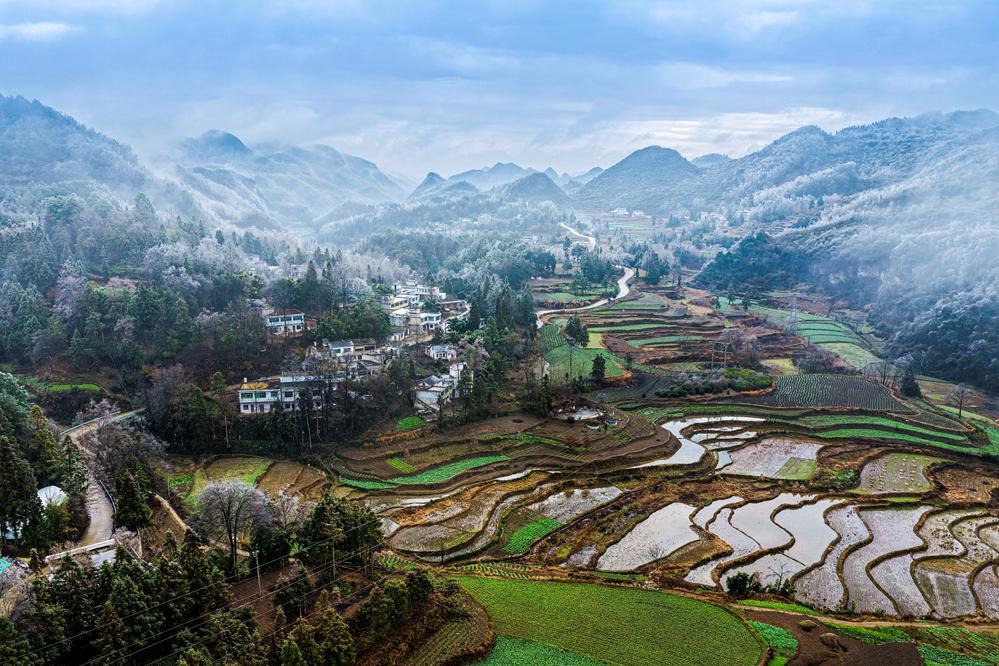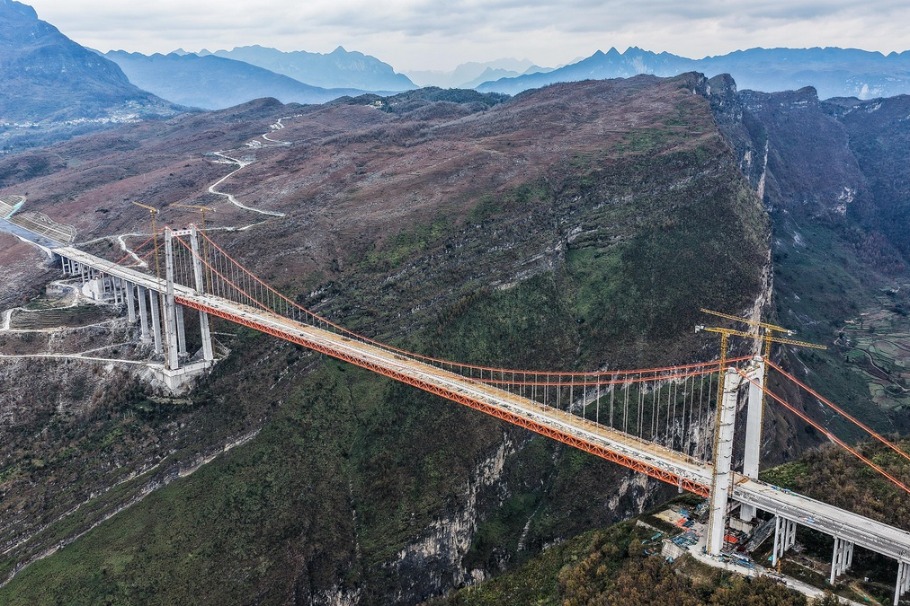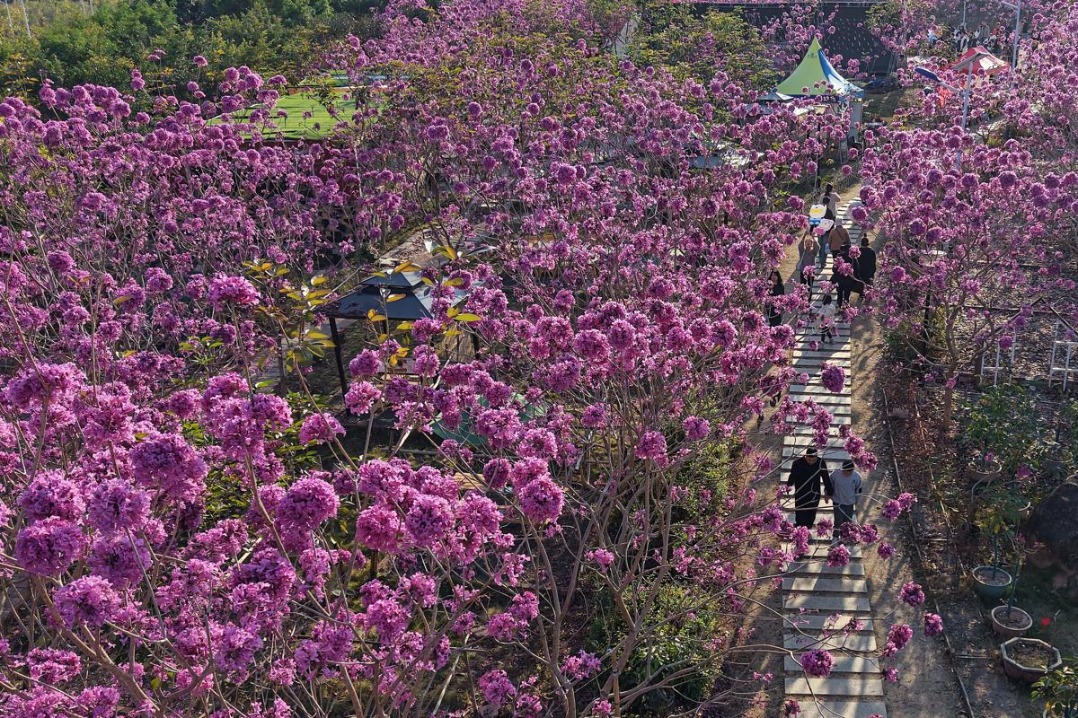Young delegates explore vibrant Xinjiang
From bustling bazaars to sustainable agriculture, modernization meets tradition and environmental care


At the bustling Xinjiang International Grand Bazaar in Urumqi, Xinjiang Uygur autonomous region, Wasina Nititawan was struck by a vibrant scene: vendors hawking rows of traditional goods in ornate packaging, and flocks of visitors that included both ethnic minority residents and Han tourists from across China.
The scene bore little resemblance to what she had envisioned.
"As I walked past stalls of dried fruits, handicrafts and cultural performances, I felt how diversity and harmony can strengthen growth," said Wasina, a Thai doctoral candidate at the Institute of South-South Cooperation and Development at Peking University.
The bazaar is a marketplace where the nation, the community and the market come together to create a lively hub of trade, tourism and culture, she said.
Wasina was one of eight representatives of the Youth Leaders' Community for Global Development who traveled to Urumqi and Kashgar as part of the 2025 China Tour. The event was organized by the Global Development Promotion Center of the China International Development Cooperation Agency.
For most in the group, Xinjiang had been a place known only through news reports. But their visits to a local community, an ancient town, a bustling market, an agricultural park and a research center allowed them to experience a region far more thriving and dynamic than many had expected.
Omar Mohamed Nagy Hussein Bauomy, an Egyptian graduate student in international education at the Minzu University of China, said he saw the same things in Xinjiang as he has seen in the rest of China.
"It is very convenient in every aspect of daily life, with well-developed transportation systems, as well as easy access to food delivery and shopping. The experience here is no different from living in Beijing," he said.
For Felix Michael Baitz, a German undergraduate student at the Frankfurt School of Finance and Management, the visit was also different from what he had heard in European media reports.
"People are very happy here. They don't feel any mistreatment, and they continue to keep their language, traditions and religion."
Baitz admitted that he had worried Xinjiang might lag behind other parts of China due to imbalanced economic development.
Instead, the 20-year-old student found rapid growth and a sense of shared progress.
"Locals told me that many of the buildings I see today weren't here when their parents were my age. They've witnessed poverty alleviation firsthand. The government is really putting an eye on the people," he said.
That people-centered approach to development is fully demonstrated in grassroots governance in the Guyuanxiang community of Tianshan district in Urumqi.
Established in 2001, the community has 5,046 residents from 14 ethnic groups, according to Zhang Yaowen, director of the neighborhood committee.
The community provides services to residents such as employment training, dispute mediation, day care for the elderly, convenience shops, and activities for retired residents and juveniles, Zhang said, adding that it also encourages local residents to participate in the management of the community.
During their visit, the delegation watched dances performed by senior residents as well as a cheerleading squad of several children.
Small events like these, Wasina said, increase real happiness and satisfaction at the grassroots level.
She found that local authorities and residents maintained close communication, with community centers actively listening to people's needs and organizing diverse activities accordingly.
"Before visiting Xinjiang, I associated Chinese modernization mainly with high-tech breakthroughs such as artificial intelligence, robotics, electric vehicles, renewable energy and the digital economy," she said. "But being here has shown me that modernization is also about building the foundations that allow people and communities to thrive."
Nadia Maunsell, an Australian student studying economics at Peking University, said that as someone working on development studies, she saw ongoing efforts in community cohesion and social development.
"One thing that really touched me was the public mechanism where people of different cultures are able to speak and solve problems together," she said. "This model of development is something that is not only relevant for China, but also globally and even for my home country in Australia, where we also have very multicultural societies and there's an importance in finding social harmony."
Agricultural innovation
In addition to grassroots governance, the group also learned about the region's innovations in science and technology during a visit to an intelligent modern agricultural pavilion, where they saw how technology can enhance vegetable growth while protecting the environment.
Inside the pavilion, more than 30 kinds of vegetable plants stretched upward in climate-controlled chambers, with auto-adjusted irrigation and sensors monitoring soil moisture and light levels. In a region with dry weather, cultivating vegetables in this way saves 95 percent of water usage.
Strolling through the park and tasting fresh, pesticide-free cucumbers, the young representatives saw modernization with a green heart.
Thinh Raksmey from Cambodia, who is also a doctoral candidate at the Institute of South-South Cooperation and Development at Peking University, said: "From planting to cultivation, the entire process incorporates environmental considerations that are really parallel to the ESG of the United Nations."
Luise Scholz, an assistant to the CEO of the dfv Euro Finance Group, said she was surprised at how advanced the technology is.
"I have the feeling that things are simply implemented and done here. In Germany, everything takes much longer because of regulations and rules," she said, adding that Germany can also learn from China in this area.
Anti-desertification efforts
At the Xinjiang Institute of Ecology and Geography, part of the Chinese Academy of Sciences, the group visited an exhibition on the region's natural history and discussed combating desertification with researchers.
Xinjiang has long stood at the forefront of China's fight against desertification. Home to the Taklimakan Desert — China's largest and the world's second-largest drifting desert — the region has seen nearby communities grapple with frequent wind and sandstorms.
In November 2024, after decades of effort, China completed a sand-blocking green belt stretching 3,046 kilometers, fully encircling the desert.
As a researcher in arid lands, Akash Tariq, an associate professor at the Xinjiang Institute of Ecology and Geography, highlighted capacity building as a particularly effective approach in desertification control.
He explained that desertification problems are often linked with unsustainable agriculture in these arid regions, and capacity building is one of the most effective ways to ensure local people understand its importance.
"The tackling of desertification is not only a job for scientists. Instead, it involves a social ecological approach that integrates scientific expertise with community participation," he said.
Maunsell, the Peking University student from Australia, noted that Xinjiang uses the best technical expertise of scientists to deploy green development solutions according to local realities.
Scientists have developed unique solutions such as planting trees along highways to prevent sandstorms, she said, adding that these technologies could also benefit neighbors in Central Asia or Africa.
Global insights
From multi-society cohesion to green development, from keeping traditions alive to seeking innovation, the journey reshaped the young representatives' understanding of Xinjiang's modernization experience.
"Chinese modernization is not a single blueprint. It adapts to local strengths, embraces diversity and seeks harmony between people, the economy and the environment," Wasina said. "For me, as a Thai, where agriculture and tourism are also central pillars, these lessons feel especially relevant. They show that development endures when it builds on a country's comparative advantages, unites all key actors and commits to long-term goals that serve both present needs and future generations."
Thinh, from Cambodia, said that by leveraging advanced technology and innovation, the region has been able to modernize production, enhance efficiency and create new value chains.
"This transformation stands as a remarkable milestone in Xinjiang's development journey and serves as compelling evidence of the success of the pairing-off cooperation between the region and more developed provincial regions in other parts of China," he said.
- China set to establish early pregnancy clinics across 10k hospitals
- Cold front coats Guizhou mountains in rime
- Two dead after unauthorized crossing of Aoshan Mountain
- China reports rise in patents and stronger IP enforcement
- Former senior Guizhou official expelled, faces prosecution
- Chinese mainland pledges to advance cause of national reunification





































